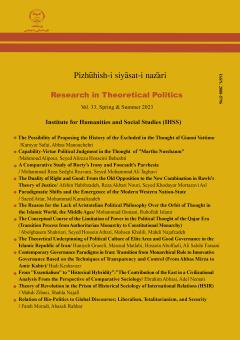In this article, historical events and cases happening from the constitutional movement to the tenth presidential election of Iran, suggesting formation or non-formation of communicative action, public sphere, civil society and democracy, have been narrated and compared
More
In this article, historical events and cases happening from the constitutional movement to the tenth presidential election of Iran, suggesting formation or non-formation of communicative action, public sphere, civil society and democracy, have been narrated and compared in a comparative study based on Boolean algebras. This study aimed at better understanding of Iranian society and identifying ups and downs that Iranian society has passed on the road to democracy regarding to communicative action, the public sphere and civil society since constitutional revolution until now, and tries to answer this question that how the relationship between communicative action, public sphere, civil society and democracy can be explained? Accordingly, the theoretical concepts of the research were reviewed and extracted from views of Arendt, Habermas, Gramsci, Lipset, Alain de Benoist and Bashiriyeh to get indices and indicators for these concepts. Then according to these indicators the situation of the communicative action, public sphere, civil society and democracy in five historical periods (since the constitutional movement to the tenth presidential election) were narrated and analyzed. During the narrative analysis of each period of time based on the presence and absence of each concept exemplar, zero (low intensity) and one (high intensity) were placed in Boolean table for each historical juncture and the relationship between these concepts were studied. Based on the findings it can be argued that despite the attempts and measures done by society, elites and part of state or government, three concepts of communicative action, public sphere and civil society were not so strong except in a few cases. Therefore, in different historical periods, lack of one of these three insufficient conditions impeded realization of democracy in Iran. Among these five historical periods, historic period of nationalization of oil is the only time that Iranian attempts to reach to the democracy has got a fruit and made democracy possible, thanks to the communicative action, public sphere and civil society. During the constitutional movement the historical cases that had traces of presence of communicative action or public sphere and during the reform era historical cases that referred to civil society and public sphere are more than the events that lack these concepts. But in the revolution and tenth presidential election of Iran the historical cases referring to communicative action, public sphere, civil society and democracy were less than events referring to these concepts.
Manuscript profile


